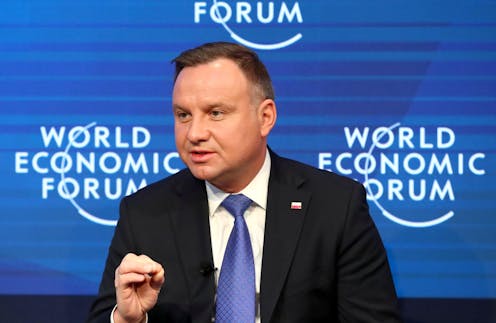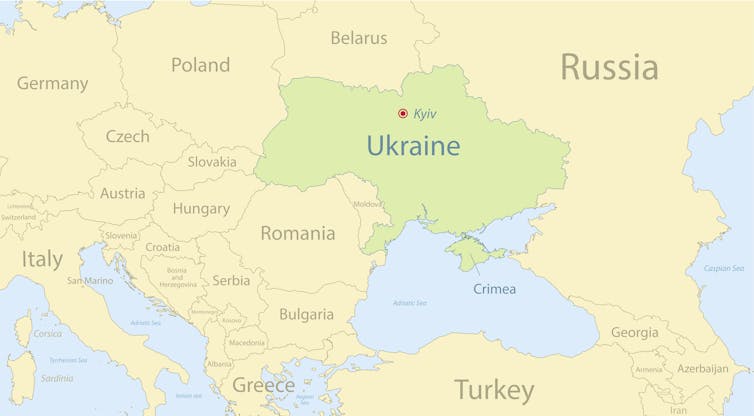
Polish president Andrzej Duda has been putting pressure on Nato allies to support Ukraine with more tanks at the World Economic Forum in Davos. This is the latest attempt by Duda to rally other countries, and particularly Germany, to support Ukraine with heavy armaments.
Duda had already announced that Poland intends to send a company of 14 German-made Leopard 2 tanks to Ukraine, but needed permission from Germany to re-export them. German vice-chancellor Robert Habeck confirmed it would support such a request. Britain has also agreed to provide 14 Challenger II tanks.
This is a decisive shift in policy, because up to this point Nato countries had refused to provide armoured vehicles or tanks. Ukrainian authorities have stated they need 300 western battle tanks to enable them to free the occupied territory.
Ever since Russia began to mass troops near the Ukrainian border in preparation for the invasion, Poland as a frontline state has played a pivotal role. Due to its geographical position, bordering both Ukraine and Belarus, Poland has become a major route for western supplies to Ukraine as well as a safe haven for Ukrainian refugees.
Poland and Ukraine have interlinked histories. Both emerged as Slavic successor states from parts of the Russian empire and parts of the Austro-Hungarian empire. The countries had a turbulent history, with ethnic, political and cultural differences and territorial issues giving rise to armed conflict in 1918-19.
The interwar period saw the integration of Ukraine in the Soviet Union, while Poland became an independent state. The territorial boundaries between them have shifted over time, and some parts of western Ukraine have traditionally been part of Poland. Polish is still widely understood in Ukraine.
Since the end of the Soviet period, Poland has been a strong supporter of Ukrainian independence and democracy. Polish national security strategy includes support for Ukraine’s further involvement in European security arrangements (and its membership of Nato). This is important for Poland to counterbalance the influence of the Russian Federation.
Poland’s risks
Poland is a Nato state in an exposed position within the Ukraine war, which partly explains why it is so proactive in providing military support for Ukraine, and is pushing other allies to do more. On November 15 2022, after a large number of Russian missile attacks on Ukraine and its energy infrastructure, a missile hit an area in the south-east of Poland, killing two men. It was most likely caused by a stray Ukrainian air defence missile, but the event illustrated the potential risks Poland is facing.

In response to this incident, the German government offered to supply Patriot air defence systems to Poland, but the Polish defence minister Mariusz Blaszczak suggested that these systems should be provided for Ukraine instead. The German government agreed to consult within the alliance.
Several hundred German soldiers will be stationed in Poland, accompanying the arrival of Patriot systems for Poland and Ukraine. Around 90-100 Ukrainian soldiers are expected to be trained by Germans based in Poland to operate one Patriot battery. As Poland’s foreign minister Zbigniew Rau stated:
“Every Pole is an expert on understanding what fighting for freedom, democracy and existential survival means. This is the case since, in our part of the world, the notion of independence means freedom from Russia.”
From the Polish perspective, the best way to prevent escalation is to provide Ukraine with the means to defeat Russian aggression. Unlike the rather restrained language of the US administration, the Polish government is quite clear in stating: “Imperialism must be stopped and defeated. Otherwise, it will be a constant threat to the free world.”
Read more: Ukraine and Poland: why the countries fell out in the past, and are now closely allied
In January 2022, Poland announced that it would provide Ukraine with weapons, ammunition and humanitarian aid, and since then has provided US$3 billion (£2.4 billion) worth of aid (including US$1.8 billion of military assistance). On February 17 2022, a Polish-British-Ukraine trilateral pact was announced to improve cybersecurity and collaborate on energy security.
Poland’s supplies for Ukraine
As the military conflict unfolded, Poland became the second-largest supplier of weapons – sending missiles, drones, tanks and other military supplies to Ukraine, as well as being a key route for the supply of weapons from the US and other Nato countries. Poland was even prepared to send MiG-29 fighter planes, although this was not approved by the US.
However, Ukraine now needs more capable air defences due to the large-scale missile and drone attacks against infrastructure and civilians.
The US is gradually changing its policy, and has signalled that it will permit Ukrainian drone attacks inside Russian territory. It also decided to provide Patriot systems to Ukraine, according to announcements in late December 2022. The training period to operate these systems has been reduced to three months.
Military analyst at the Brookings Institution Michael O’Hanlon explained: “Going step by step has helped Ukraine patch up vulnerabilities, to be sure. But it hasn’t furthered the goal of formulating a strategy to end the war, or defining the capacity that will be ultimately needed to do so.”
A new phase of the conflict is beginning. For Poland, it is crucial that Ukraine defeats Russian aggression. Otherwise the security of Europe as a whole, and Poland in particular, would be at risk.
Christoph Bluth received funding from the Nuclear History Program, a NATO Research Fellowship, the Volkswagen Stiftung and the Leverhulme Trust
This article was originally published on The Conversation. Read the original article.







